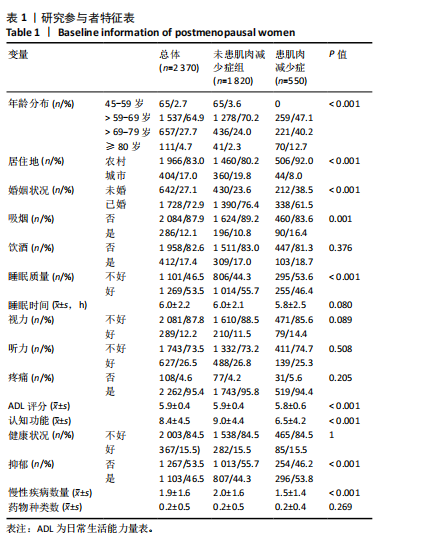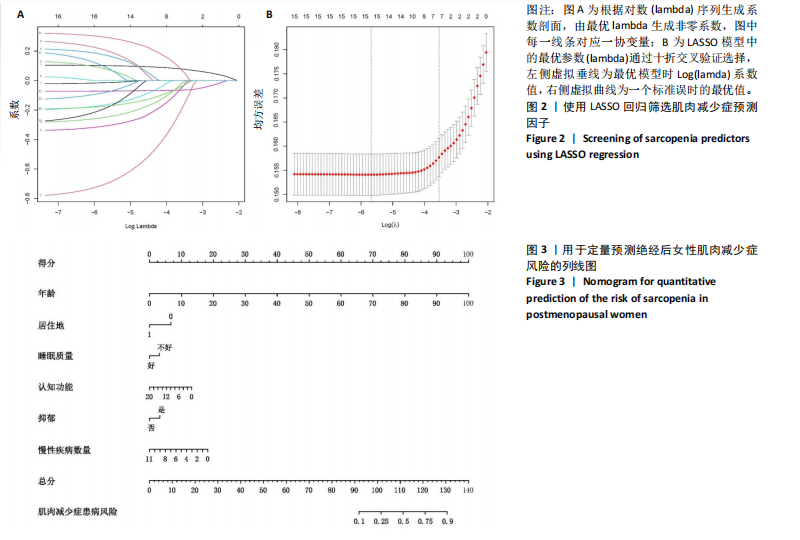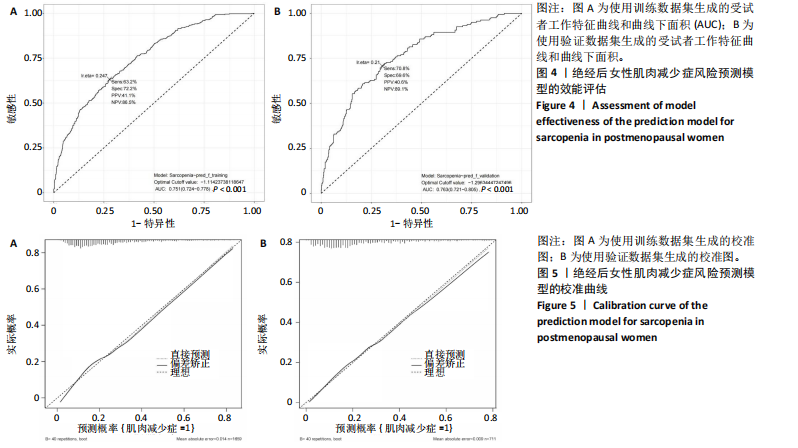[1] ROSENBERG IH. Sarcopenia: origins and clinical relevance. J Nutr. 1997; 127(5 Suppl):990s-991s.
[2] BEAUDART C, DEMONCEAU C, REGINSTER JY, et al. Sarcopenia and health-related quality of life: A systematic review and meta-analysis. J Cachexia Sarcopenia Muscle. 2023;14(3):1228-1243.
[3] MIELGO-AYUSO J, FERNÁNDEZ-LÁZARO D. Sarcopenia, Exercise and Quality of Life. Int J Environ Res Public Health. 2021;18(10):5156.
[4] JIMENEZ-GUTIERREZ GE, MARTÍNEZ-GÓMEZ LE, MARTÍNEZ-ARMENTA C, et al. Molecular Mechanisms of Inflammation in Sarcopenia: Diagnosis and Therapeutic Update. Cells. 2022;11(15):2359.
[5] CHEN LK, LIU LK, WOO J, et al. Sarcopenia in Asia: consensus report of the Asian Working Group for Sarcopenia. J Am Med Dir Assoc. 2014;15(2):95-101.
[6] CHEN LK, WOO J, ASSANTACHAI P, et al. Asian Working Group for Sarcopenia: 2019 Consensus Update on Sarcopenia Diagnosis and Treatmen. J Am Med Dir Assoc. 2020;21(3):300-307.e302.
[7] LAVIANO A, GORI C, RIANDA S. Sarcopenia and nutrition. Adv Food Nutr Res. 2014;71:101-136.
[8] PAPADOPOULOU SK. Sarcopenia: A Contemporary Health Problem among Older Adult Populations. Nutrients. 2020;12(5):1293.
[9] ALBANO D, MESSINA C, VITALE J, et al. Imaging of sarcopenia: old evidence and new insights. Eur Radiol. 2020;30(4):2199-2208.
[10] MINETTO MA, BUSSO C, GAMERRO G, et al. Quantitative assessment of volumetric muscle loss: Dual-energy X-ray absorptiometry and ultrasonography. Curr Opin Pharmacol. 2021;57:148-156.
[11] JIMENEZ-GUTIERREZ GE, MARTÍNEZ-GÓMEZ LE, MARTÍNEZ-ARMENTA C, et al. Molecular Mechanisms of Inflammation in Sarcopenia: Diagnosis and Therapeutic Update. Cells. 2022;11(15):2359.
[12] CHENG KY, CHOW SK, HUNG VW, et al. Diagnosis of sarcopenia by evaluating skeletal muscle mass by adjusted bioimpedance analysis validated with dual-energy X-ray absorptiometry. J Cachexia Sarcopenia Muscle. 2021;12(6):2163-2173.
[13] BEAUDART C, MCCLOSKEY E, BRUYÈRE O, et al. Sarcopenia in daily practice: assessment and management. BMC Geriatr. 2016;16(1):170.
[14] CRUZ-JENTOFT AJ, SAYER AA. Sarcopenia. Lancet. 2019;393(10191): 2636-2646.
[15] CAPPOLA AR, SHOBACK DM. Osteoporosis Therapy in Postmenopausal Women With High Risk of Fracture. JAMA. 2016;316(7):715-716.
[16] BERTOMEU-GONZALEZ V, CORDERO A, RUIZ-NODAR JM, et al. Risk factors for major adverse cardiovascular events in postmenopausal women: UK Biobank prospective cohort study. Atherosclerosis. 2023; 386:117372.
[17] HENDRYX M, NICHOLSON W, MANSON JE, et al. Social Relationships and Risk of Type 2 Diabetes Among Postmenopausal Women. J Gerontol B Psychol Sci Soc Sci. 2020;75(7):1597-1608.
[18] 陶敏芳.始于围绝经期的更年期和老年期妇女健康保健策略[J].上海医学,2021,44(6):388-390.
[19] DIVARIS E, ANAGNOSTIS P, GKEKAS NK, et al. Early menopause and premature ovarian insufficiency may increase the risk of sarcopenia: A systematic review and meta-analysis. Maturitas. 2023;175:107782.
[20] LU L, TIAN L. Postmenopausal osteoporosis coexisting with sarcopenia: the role and mechanisms of estrogen. J Endocrinol. 2023; 259(1):e230116.
[21] GERACI A, CALVANI R, FERRI E, et al. Sarcopenia and Menopause: The Role of Estradiol. Front Endocrinol (Lausanne). 2021;12:682012.
[22] ANAGNOSTIS P, SIOLOS P, GKEKAS NK, et al. Association between age at menopause and fracture risk: a systematic review and meta-analysis. Endocrine. 2019;63(2):213-224.
[23] LIU JH. Sarcopenia and menopause. Menopause. 2023;30(2):119-120.
[24] SI Y, HANEWALD K, CHEN S, et al. Life-course inequalities in intrinsic capacity and healthy ageing, China. Bull World Health Organ. 2023; 101(5):307-316c.
[25] HU Y, PENG W, REN R, et al. Sarcopenia and mild cognitive impairment among elderly adults: The first longitudinal evidence from CHARLS. J Cachexia Sarcopenia Muscle. 2022;13(6):2944-2952.
[26] ZHAO Y, HU Y, SMITH JP, et al. Cohort profile: the China Health and Retirement Longitudinal Study (CHARLS). Int J Epidemiol. 2014;43(1) 61-68.
[27] WU X, LI X, XU M, et al. Sarcopenia prevalence and associated factors among older Chinese population: Findings from the China Health and Retirement Longitudinal Study. PLoS One. 2021;16(3):e0247617.
[28] ZHANG L, GUO L, WU H, et al. Role of physical performance measures for identifying functional disability among Chinese older adults: Data from the China Health and Retirement Longitudinal Study. PLoS One. 2019;14(4):e0215693.
[29] WEN X, WANG M, JIANG CM, et al. Anthropometric equation for estimation of appendicular skeletal muscle mass in Chinese adults. Asia Pac J Clin Nutr. 2011;20(4):551-556.
[30] YANG M, HU X, WANG H, et al. Sarcopenia predicts readmission and mortality in elderly patients in acute care wards: a prospective study. J Cachexia Sarcopenia Muscle. 2017;8(2):251-258.
[31] HUANG W, ZHOU Y. Effects of education on cognition at older ages: evidence from China’s Great Famine. Soc Sci Med. 2013;98:54-62.
[32] BU F, DENG XH, ZHAN NN, et al. Development and validation of a risk prediction model for frailty in patients with diabetes. BMC Geriatr. 2023;23(1):172.
[33] HU JY, WANG Y, TONG XM, et al. When to consider logistic LASSO regression in multivariate analysis? Eur J Surg Oncol. 2021;47(8):2206.
[34] LYU J, LI Z, WEI H, et al. A potent risk model for predicting new-onset acute coronary syndrome in patients with type 2 diabetes mellitus in Northwest China. Acta Diabetol. 2020;57(6):705-713.
[35] TOURNADRE A, VIAL G, CAPEL F, et al. Sarcopenia. Joint Bone Spine. 2019;86(3):309-314.
[36] DAMLUJI AA, ALFARAIDHY M, ALHAJRI N, et al. Sarcopenia and Cardiovascular Diseases. Circulation. 2023;147(20):1534-1553.
[37] WANG LT, HUANG WC, HUNG YC, et al. Association between Depressive Symptoms and Risk of Sarcopenia in Taiwanese Older Adults. J Nutr Health Aging. 2021;25(6):790-794.
[38] YUAN S, LARSSON SC. Epidemiology of sarcopenia: Prevalence, risk factors, and consequences. Metabolism. 2023;144:155533.
[39] WILKINSON DJ, PIASECKI M, ATHERTON PJ. The age-related loss of skeletal muscle mass and function: Measurement and physiology of muscle fibre atrophy and muscle fibre loss in humans. Ageing Res Rev. 2018;47:123-132.
[40] CURTIS E, LITWIC A, COOPER C, et al. Determinants of Muscle and Bone Aging. J Cell Physiol. 2015;230(11):2618-2625.
[41] MALTAIS ML, DESROCHES J, DIONNE IJ. Changes in muscle mass and strength after menopause. J Musculoskelet Neuronal Interact. 2009;9(4):186-197.
[42] LU X, CHU H, WANG L, et al. Age- and sex-related differences in muscle strength and physical performance in older Chinese. Aging Clin Exp Res. 2020;32(5):877-883.
[43] HAH YS, LEE WK, LEE S, et al. β-Sitosterol Attenuates Dexamethasone-Induced Muscle Atrophy via Regulating FoxO1-Dependent Signaling in C2C12 Cell and Mice Model. Nutrients. 2022;14(14):2894.
[44] NISHIKAWA H, FUKUNISHI S, ASAI A, et al. Pathophysiology and mechanisms of primary sarcopenia (Review). Int J Mol Med. 2021; 48(2):156.
[45] LU L, MAO L, FENG Y, et al. Effects of different exercise training modes on muscle strength and physical performance in older people with sarcopenia: a systematic review and meta-analysis. BMC Geriatr. 2021;21(1):708.
[46] WANG HH, SUN YN, QU TQ, et al. Nobiletin Prevents D-Galactose-Induced C2C12 Cell Aging by Improving Mitochondrial Function. Int J Mol Sci. 2022;23(19):11963.
[47] CRITCHLOW AJ, HIAM D, WILLIAMS R, et al. The role of estrogen in female skeletal muscle aging: A systematic review. Maturitas. 2023; 178:107844.
[48] MANGAN G, IQBAL S, HUBBARD A, et al. Delay in post-ovariectomy estrogen replacement negates estrogen-induced augmentation of post-exercise muscle satellite cell proliferation. Can J Physiol Pharmacol. 2015;93(11):945-951.
[49] PELLEGRINO A, TIIDUS PM, VANDENBOOM R. Mechanisms of Estrogen Influence on Skeletal Muscle: Mass, Regeneration, and Mitochondrial Function. Sports Med. 2022;52(12):2853-2869.
[50] FAN L, WANG Z, ZHAO Y, et al. Urban-Rural Disparities in Knowledge, Use and Perceived Benefits of Nutrition Labels in China: Evidence from 10 Provinces. Nutrients. 2023;15(5):1171.
[51] 李建新,李春华.城乡老年人口健康差异研究[J].人口学刊,2014, 36(5):37-47.
[52] CORBO I, FORTE G, FAVIERI F, et al. Poor Sleep Quality in Aging: The Association with Mental Health. Int J Environ Res Public Health. 2023;20(3):1661.
[53] PIOVEZAN RD, ABUCHAM J, DOS SANTOS RV, et al. The impact of sleep on age-related sarcopenia: Possible connections and clinical implications. Ageing Res Rev. 2015;23(Pt B):210-220.
[54] RAWTAER I, MAHENDRAN R, CHAN HY, et al. A nonpharmacological approach to improve sleep quality in older adults. Asia Pac Psychiatry. 2018;10(2):e12301.
[55] CHANG KV, HSU TH, WU WT, et al. Association Between Sarcopenia and Cognitive Impairment: A Systematic Review and Meta-Analysis. J Am Med Dir Assoc. 2016;17(12):1164.e1167-1164.e1115.
[56] ROBERTSON DA, SAVVA GM, KENNY RA. Frailty and cognitive impairment--a review of the evidence and causal mechanisms. Ageing Res Rev. 2013;12(4):840-851.
[57] CHOU MY, NISHITA Y, NAKAGAWA T, et al. Role of gait speed and grip strength in predicting 10-year cognitive decline among community-dwelling older people. BMC Geriatr. 2019;19(1):186.
[58] LI Z, TONG X, MA Y, et al. Prevalence of depression in patients with sarcopenia and correlation between the two diseases: systematic review and meta-analysis. J Cachexia Sarcopenia Muscle. 2022;13(1):128-144.
[59] LIALY HE, MOHAMED MA, ABDALLATIF LA, et al. Effects of different physiotherapy modalities on insomnia and depression in perimenopausal, menopausal, and post-menopausal women: a systematic review. BMC Womens Health. 2023;23(1):363.
[60] LEACH LS, CHRISTENSEN H, MACKINNON AJ, et al. Gender differences in depression and anxiety across the adult lifespan: the role of psychosocial mediators. Soc Psychiatry Psychiatr Epidemiol. 2008;43(12):983-998.
[61] KESSLER RC, MCGONAGLE KA, ZHAO S, et al. Lifetime and 12-month prevalence of DSM-III-R psychiatric disorders in the United States. Results from the National Comorbidity Survey. Arch Gen Psychiatry. 1994;51(1):8-19.
[62] KRIS-ETHERTON PM, PETERSEN KS, HIBBELN JR, et al. Nutrition and behavioral health disorders: depression and anxiety. Nutr Rev. 2021;79(3):247-260.
[63] AROSIO B, CESARI M. Nutrition and Muscle Health. Nutrients. 2021; 13(3):797.
[64] ROSHANAEI-MOGHADDAM B, KATON WJ, RUSSO J. The longitudinal effects of depression on physical activity. Gen Hosp Psychiatry. 2009; 31(4):306-315.
[65] PARK H, KIM K. Depression and Its Association with Health-Related Quality of Life in Postmenopausal Women in Korea. Int J Environ Res Public Health. 2018;15(11):2327.
[66] ZHANG X, ZHAO Y, CHEN S, et al. Anti-diabetic drugs and sarcopenia: emerging links, mechanistic insights, and clinical implications. J Cachexia Sarcopenia Muscle. 2021;12(6):1368-1379.
[67] VAN BAKEL SIJ, GOSKER HR, LANGEN RC, et al. Towards Personalized Management of Sarcopenia in COPD. Int J Chron Obstruct Pulmon Dis. 2021;16:25-40.
[68] TANDON P, MONTANO-LOZA AJ, LAI JC, et al. Sarcopenia and frailty in decompensated cirrhosis. J Hepatol. 2021;75 Suppl 1(Suppl 1): S147-s162.
[69] YANG J, JIANG F, YANG M, et al. Sarcopenia and nervous system disorders. J Neurol. 2022; 269(11):5787-5797.
[70] NOCE A, MARRONE G, OTTAVIANI E, et al. Uremic Sarcopenia and Its Possible Nutritional Approach. Nutrients. 2021;13(1):147.
[71] MO YH, SU YD, DONG X, et al. Development and Validation of a Nomogram for Predicting Sarcopenia in Community-Dwelling Older Adults. J Am Med Dir Assoc. 2022;23(5):715-721.
[72] HAN S, ZHANG F, YU H, et al. Systemic inflammation accelerates the adverse effects of air pollution on metabolic syndrome: Findings from the China health and Retirement Longitudinal Study (CHARLS). Environ Res. 2022;215(Pt 1):114340. |




